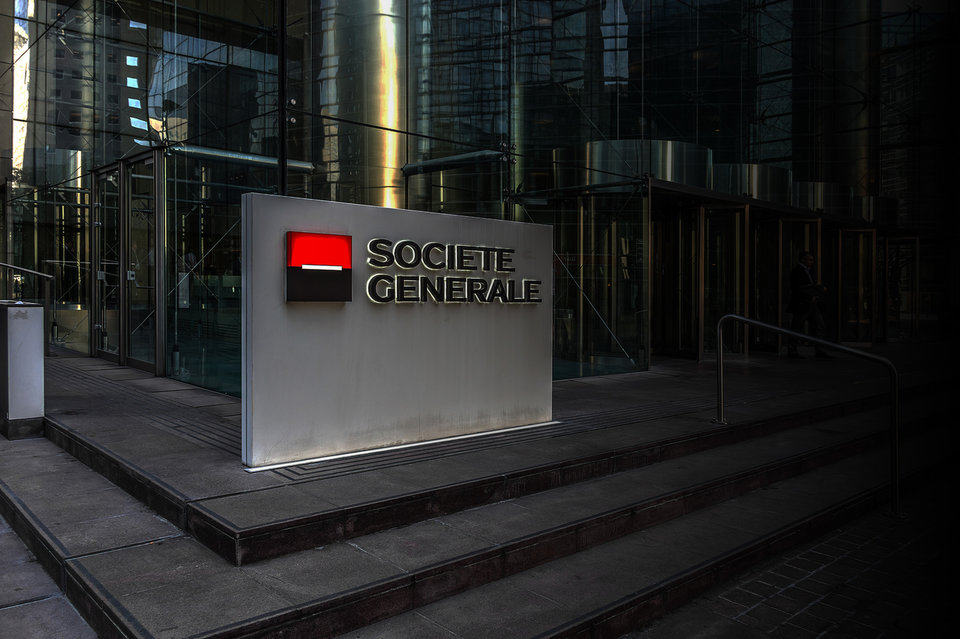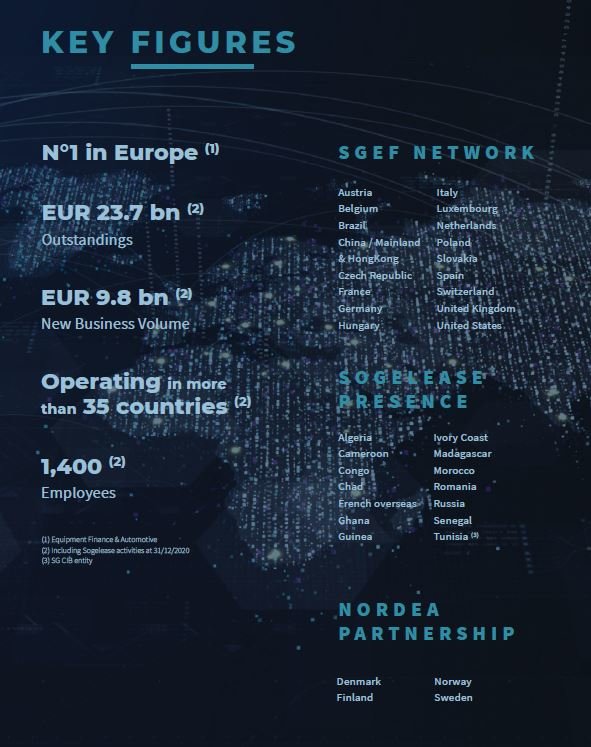Leasing
Where we are going and how we’ll get there
Société Générale Equipment Finance’s CEO, Jochen Jehmlich, offers his view on the future of asset finance and leasing. He looks at how the sector will be impacted by new technologies, new ways of working and new consumption models, and considers who stands to benefit from the ‘new normal’

W
e cannot talk about the future of the leasing market without assessing how the Covid-19 crisis will impact and change our lives.
We have been facing an unprecedented economic crisis for almost a year now, due to a health crisis we were unprepared for, and it has changed all of us, both our personal lives and in the business sphere.
As we move forward, the effects of Covid will mean there will be structural changes in our lives, behaviours and a new pattern for the global economy – and the asset finance industry.
Some trends will accelerate: new technologies, environmental considerations, new ways of working, new consumption models – but how will the asset finance sector be impacted by all of this? Who will benefit from these changes? And, what will be the “new normal”?
First lockdown
The March 2020 lockdown and its unprecedented impact on our daily lives pushed us to go back to basics and focus on key priorities to properly manage the crisis, our partners and clients’ requests and the available resources. Reliability, connectivity and agility have quickly proven to be the most important values.
Businesses that were at the cutting edge – in terms of remote working models and digitalisation – were able to adapt far more quickly to the new conditions, and to even increase their business volumes during the first phase of the crisis. No doubt, they will stay ahead and capitalise on their head start in the “new normal” context after Covid.
On the contrary, businesses that lagged behind have had to admit that digitalisation and connectivity are not just nice to have. To ensure and maintain their reliability and efficiency in the future, lessors who want to thrive will need to invest in digitalisation.

SFG Stats. Credit: Société Générale Equipment Finance
Digitalisation
‘Digitalisation’ has become a buzzword in the industry. If lessors’ objective is to support vendors, manufacturers and SMEs in their activities to help sell more or invest, digitalisation should therefore help us to be more efficient in supporting them.
The use of e-signature has become the new norm. The next step is the full informatisation of internal processes. But are all clients ready for a full digital relationship with their lessors and funders? Are they comfortable with a “no touch” business environment?
We are typically dealing with all sorts of different situations, with some clients asking for a greater digital relationship, but others wanting a more traditional business relationship. It is crucial to identify clients’ individual requirements, see where they are in their digital journey and what are the blocking points that could be resolved with a digital solution. In some cases, partnering with a fintech is the answer for a client needing to quickly adapt to new conditions.
There are things to watch out for even with digitalisation of all processes, as the algorithms that businesses typically use, particularly in terms of credit scoring, might be using data that is now out of date in the new economic climate. This could affect credit approvals for customers based on scores that no longer reflect the reality of their situation, post crisis.
So, on the one hand, the Covid crisis has helped us identify what is critical for our processes. But on the other hand, it has also complicated some digitalisation projects.
Jochen Jehmlich, CEO, Société Générale Equipment Finance
New technologies
Before Covid, the emergence of new technologies and the pace of change, in line with digitalisation needs, were impressive. However, since the start of the crisis, we have seen a greater uptake in the adoption, new usage and the development of technology from collaborative platforms (in the health sector for instance, we saw worldwide specialists’ networks collaborating to improve diagnostic tools); telemedicine; remote work of course; video conferences (how many of us had even heard of Zoom before March 2020?); cloud computing, etc.
New assets are emerging from these new or increased uses of technology, and we as lessors and as broader solution providers have to know about and understand these assets and their specific dynamics. Data management is another area of expertise that is fast developing.
Geographical coverage
The crisis also emphasised the importance of having wide geographical coverage for lessors, notably for international clients and partners, with geographical consistency, tailored to local market conditions.
During the first phase of the crisis, we had to provide the same level of service everywhere and to be aligned even if the specific situation differed from country to country. A universal approach was essential for vendors who expected to manage all their assets and clients simultaneously and consistently. Major actors may have succeeded better than smaller players capitalising on wide geographical coverage, reactivity, alignment and partnership.
Major actors may have succeeded better than smaller players capitalising on wide geographical coverage, reactivity, alignment and partnership.
At SGEF, we could rely on the strong relationships we have built up over the long term with our vendors and partners. For them, we launched a programme, #StrongerTogether, at the beginning of the crisis that has been extended until March 2021. The objective is to support international and local vendors, dealers, partners and existing end-customers with flexible financing to encourage additional equipment sales and stimulate the restart of their businesses. A package of €1bn in new investment was made available throughout SGEF network. We strongly believe that the future of the leasing industry will involve win-win partnerships with vendors and partners.
From the beginning of the crisis, customers have been carefully managing their liquidity positions and this has expanded the scope of funding solutions for equipment financiers, including SGEF, winning traction with some corporates which used to pay cash and are now more favourably looking at leasing solutions or payment plans. Leasing has been perceived as an added-value product allowing flexibility in asset management.
The question for the future is: will companies continue to use more leasing solutions after the crisis when cash management will be back to normal and the short-term digital boost stabilised?
The future of work
As I said earlier, digitalisation should help us to maintain the rapidity of change. But we will also have human challenges. The sudden switch to telecommuting that we have experienced during the Covid crisis has turned our organisations, professional practices and habits upside down. It highlighted the systemic vulnerability that individuals and businesses are now facing (the individual, democratic, social, economic and environmental risks) and raised a few questions.
Expectations are high, as are the risks and challenges we face in the new relationships between companies and their employees that have emerged since the crisis, where the boundaries between our professional and personal lives have become permeable and where each organisation must question its contribution to society more than ever.
Sustainability
The Covid crisis has also heightened our awareness of our environmental responsibilities, and maybe led to a certain amount of collective guilt. As a result, we anticipate an increased appetite for green assets in the coming years that we are looking forward to.
To support our clients and partners’ energy-transition investments, SGEF has put Corporate Social Responsibility (CSR) at the heart of its strategy. Over the next five years, we intend to focus a growing share of our finance portfolio on sustainable business concepts and financing solutions: energy efficiency, electrification, investments in sustainable equipment such as photovoltaic. The circular economy will be an integrated into our asset lifecycle management approach to ensure that resources are used and reused in an environmentally positive way. Asset lifecycle management is a challenge for the leasing industry and the environment. Lessees are increasingly focused on the improvement of their asset life cycle management. And the crisis has just made it even more tangible. We expect here an acceleration, notably in the healthcare sector.
In that respect, we have been closely working with Philips Healthcare for several years. Thanks to our partnership, we are managing a total residual value risk portfolio for medical equipment. In this case the end-user is exchanging or returning the asset at the end of the financing, and the medical equipment is then refurbished and re-sold with financing support in a different market.
Of course, the circular economy is far from a complete solution. There is still a lot of waste and there is a gap between what we want to achieve collectively – lessors, vendors, manufacturers and end users – and what can efficiently be refurbished and re-used. We should also be aware that not everyone will be able to afford investing in sustainable technology. With some companies fighting to survive their primary concern is cost cutting and as a result investment in their future is often delayed or shelved entirely. As a major actor in the leasing industry, we have the responsibility to support corporates who want to set up efficient sustainable strategies, while continuing to finance the real economy.
Usage vs ownership
The last challenge I would like to mention for the future of the leasing industry is the new models of consumption. Not all of these are entirely new, but they are likely to accelerate over the coming years, notably with the emergence new technologies. The future is in pay-per-use (and bundled offers) vs ownership.
End customers, whether individuals or companies, are gradually changing their consumption models reflecting their demand to pay for the usage of the assets rather than the assets themselves. Owning the equipment is no longer a must: you may need a hole but not a drill. More end-users prefer to allocate their resources into their core business rather than investing in asset ownership. They are also less willing to take the risk of technology obsolescence. Of course, the pace of those changes varies greatly from sector to sector, as well as on the assets, and from the country to country. Culture is also a key parameter for those structural changes; the arrival of new generations to leadership positions will accelerate the trend.
In conclusion, I am optimistic about the future of the asset finance and leasing markets. Collectively, we have shown resilience, we are embracing the digitalisation of our processes and client journeys, we are accompanying the environmental transition and taking responsibility for it, and we are shaping new models of working. Even if the global economy and the end of the Covid crisis are uncertain, we are capable of maintaining a high level of service to our clients. We will continue to support the real economy all over the world building reliable and trusted relationships and partnerships with our vendors and clients.
This is an edited version of a keynote address which Jochen Jehmlich gave in November at the 16th Leasing Life Conference 2020.